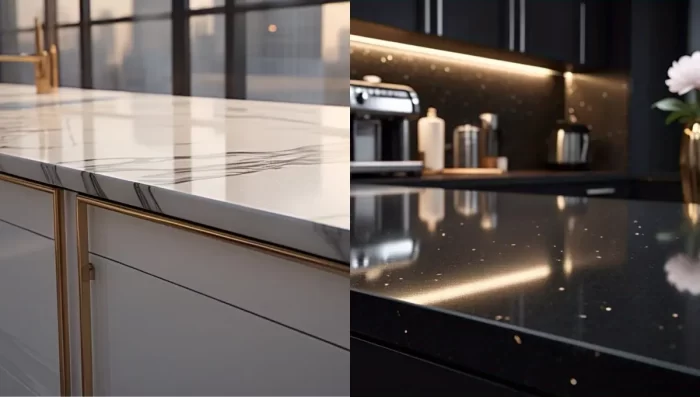Introduction to Beveled Edge Countertop
Let’s be honest – your kitchen deserves better than ‘basic’ edges. Enter the beveled edge countertop: the happy medium between ‘I woke up like this’ straight edges and ‘high maintenance’ ornate profiles.
It’s like the mullet of countertop edges – business on the surface, party on the slope (okay, a very small, tasteful party).
In this post, we’ll explore their benefits, materials, maintenance, and how they compare to other edge styles.
- Introduction to Beveled Edge Countertop
- Types of Beveled Edge: Which One Fits Your Style?
- Beveled Edge vs Other Edge Styles
- Best Materials for Beveled Edge Countertops
- Best Rooms for Beveled Edge Countertops
- Benefits of Beveled Edge Countertops
- Any Downsides?
- How to Clean a Beveled Edge Countertop
- Tips to Keep It Looking New
- Cost of Beveled Edge Countertops
- Can you create a beveled edge yourself, or should you hire a professional?
- Final Thoughts
- FAQs about beveled edge countertop
What Is a Beveled Edge Countertop?
A beveled edge countertop has a slanted edge instead of a straight or rounded one. It’s cut at a small angle, usually 45 degrees. This gives your countertop a neat and stylish look. You’ll often see it in kitchens and bathrooms because it adds a touch of class.
Why Edges Matter in Countertops?
Think of edges like the haircut for your countertop. They change how it looks, feels, and even how easy it is to clean. A cool edge, like the beveled one, makes a big difference in your home’s design.
What Does “Beveled” Mean?
“Beveled” just means the edge is cut at an angle. Instead of going straight down, it slants in a bit. It’s kind of like slicing the corner off a cube.
How Is a Beveled Edge Made?
The edge is shaped using special machines. These machines carefully cut the countertop at a slant. After that, the edge is polished to make it smooth and shiny.
Also Read: Straight Edge Countertops
Types of Beveled Edge: Which One Fits Your Style?
Not all beveled edges are created equal! Depending on the angle, depth, and design, you can get different looks—from subtle to statement-making. Here are the most popular types:
1. Standard Bevel (Top Bevel)
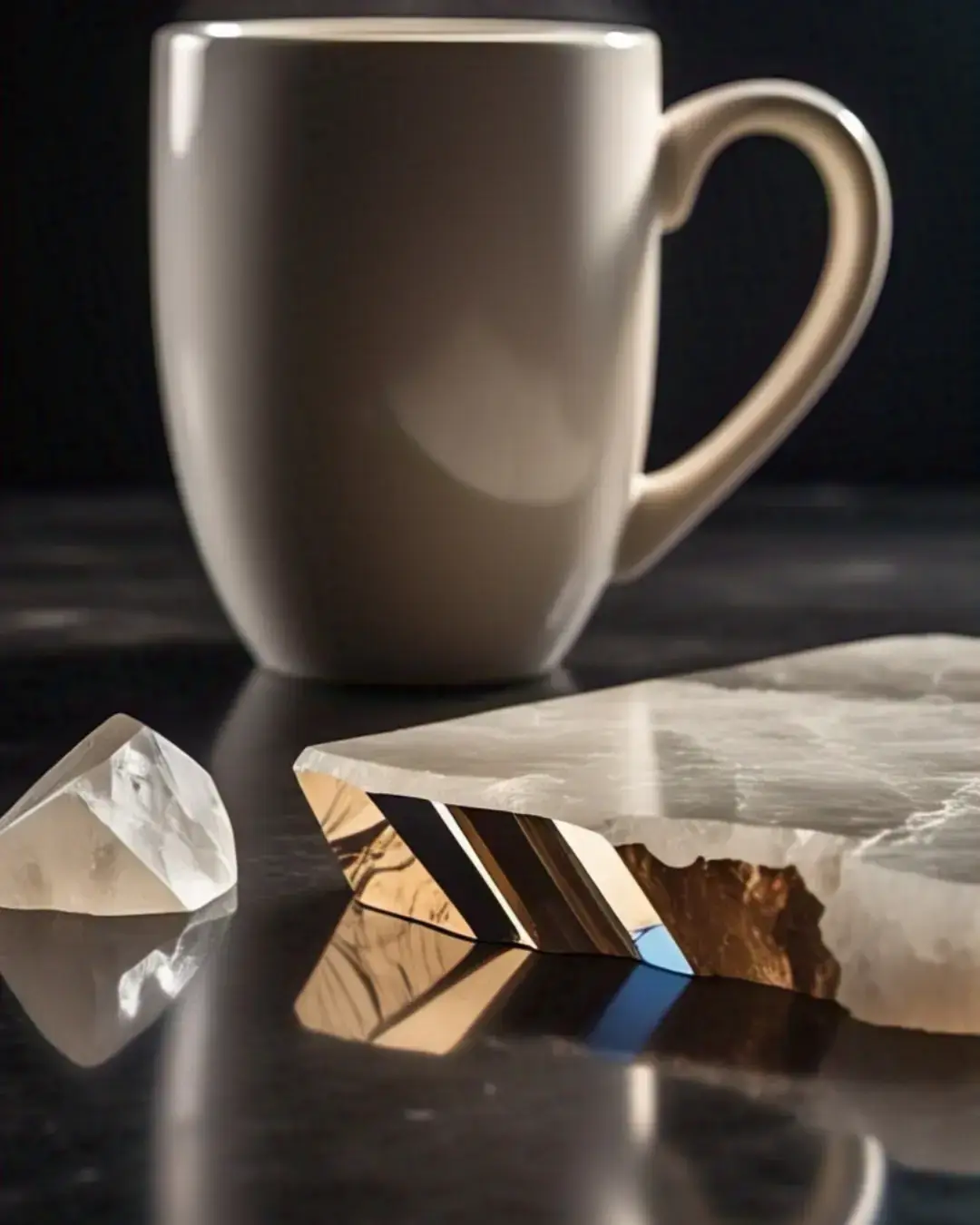
- What it looks like: A single slanted cut (usually 45°) along the top edge only
- Best for: A clean, slightly upgraded look
- Works well with: All countertop materials (quartz, granite, laminate)
- Fun fact: The most common (and affordable) bevel style
2. Double Bevel (Top & Bottom Bevel)
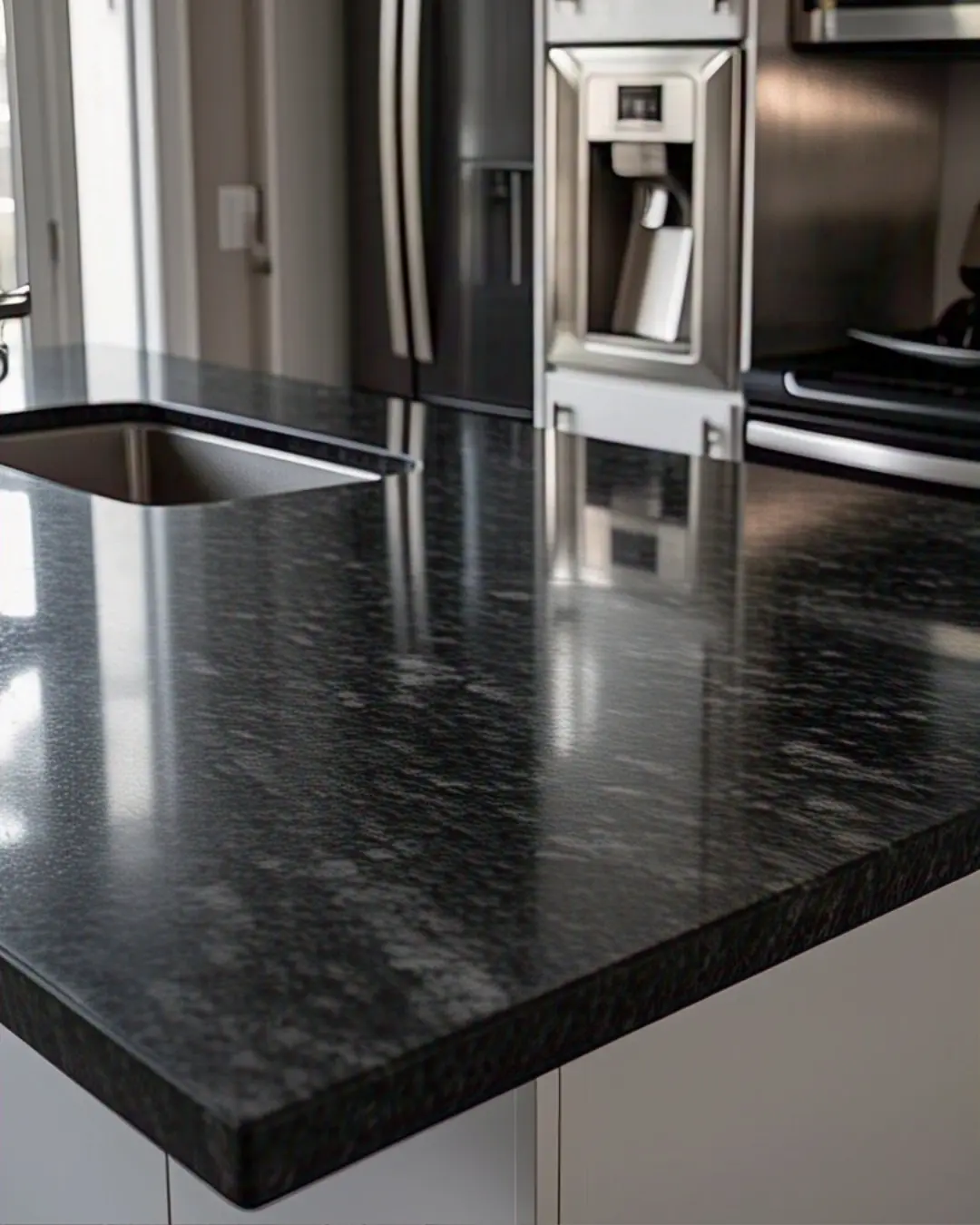
- What it looks like: Angled cuts on both the top and bottom edges for symmetry
- Best for: A more polished, high-end appearance
- Bonus: Makes countertops look thinner and sleeker
- Common in: Modern and luxury kitchens
3. Decorative Bevel (Layered or Stepped)
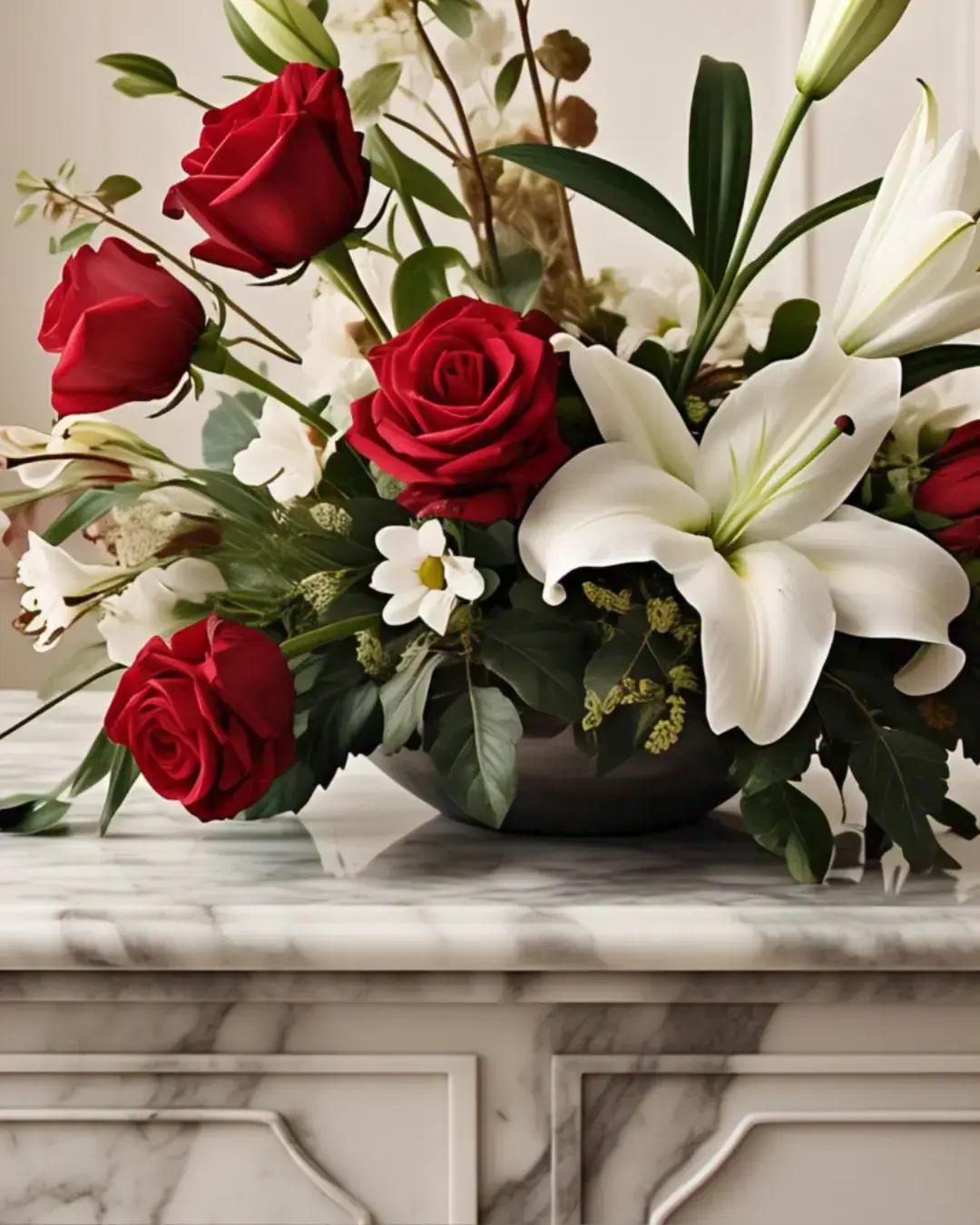
- What it looks like: Multiple angled cuts (like tiny stair steps) for extra detail
- Best for: Traditional or ornate kitchens
- Watch out: Harder to clean (crumbs love those grooves!)
- Material match: Best with granite or marble
4. Soft Bevel (Rounded Bevel)

- What it looks like: A gentle slope with slightly rounded edges
- Best for: Families (no sharp corners!) or rustic designs
- Safety win: Less likely to chip than sharp angles
- Popular with: Soapstone or wood countertops
Also Read: Eased Edge Countertop
Which Bevel Type Should You Choose?
| Type | Best For | Maintenance |
|---|---|---|
| Standard Bevel | Budget-friendly upgrade | Easy |
| Double Bevel | Modern, sleek kitchens | Moderate |
| Decorative Bevel | Fancy traditional spaces | High |
| Soft Bevel | Family-friendly kitchens | Easy |
Pro Tip: Love the look but hate cleaning? Go for a standard or double bevel—they’re crumb-resistant!
Whether you want a tiny slope or a dramatic angle, there’s a beveled edge for every kitchen. Now all you need to do is pick your favorite and start cooking!
Beveled Edge vs Other Edge Styles
Wondering how a beveled edge compares to other types? Let’s break it down:
Beveled vs Rounded Edge
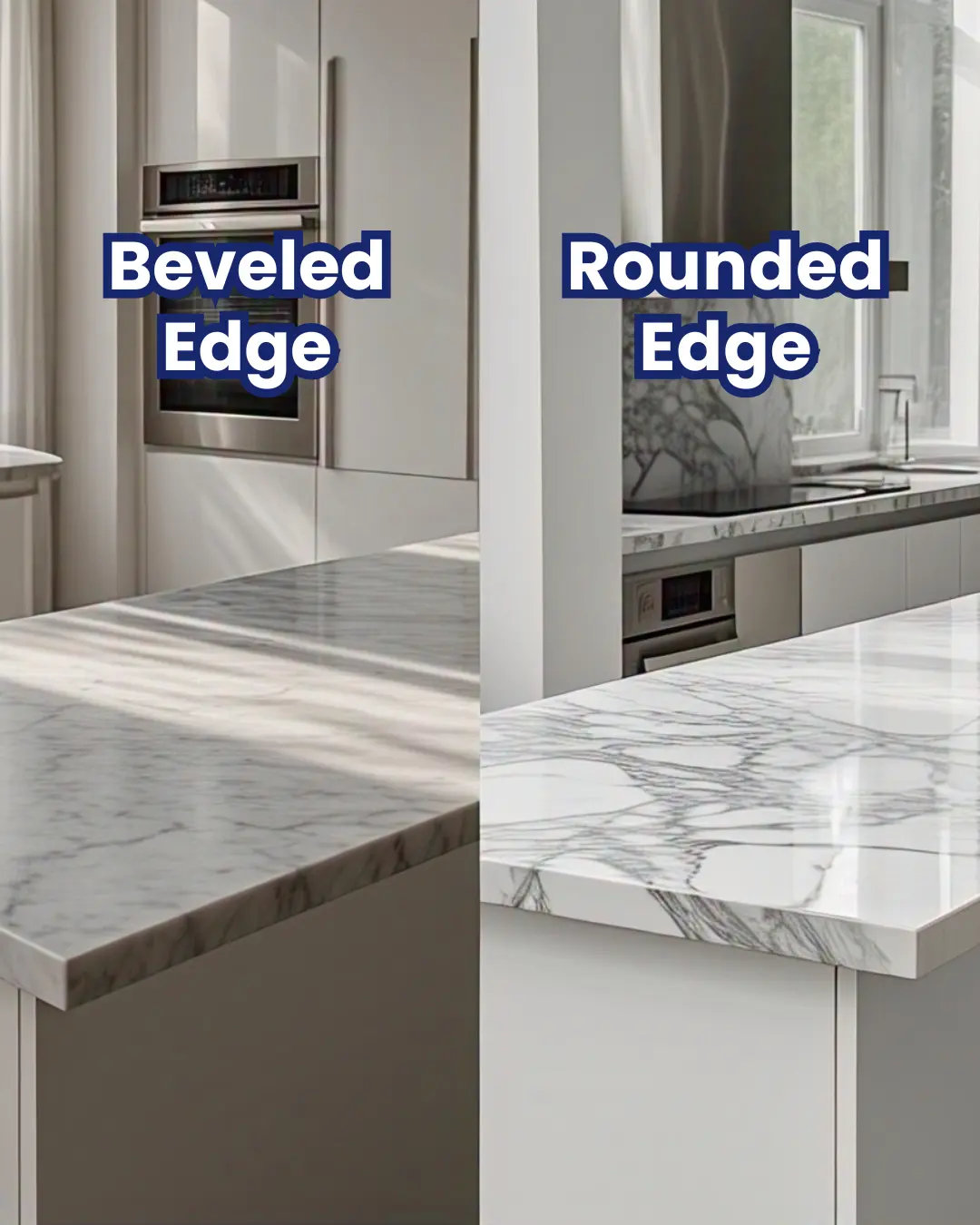
- Beveled: Sharp and angled.
- Rounded: Smooth and curved.
- Which is better? If you want a modern look, go with beveled. For safety (like with kids), rounded is great.
Beveled vs Bullnose
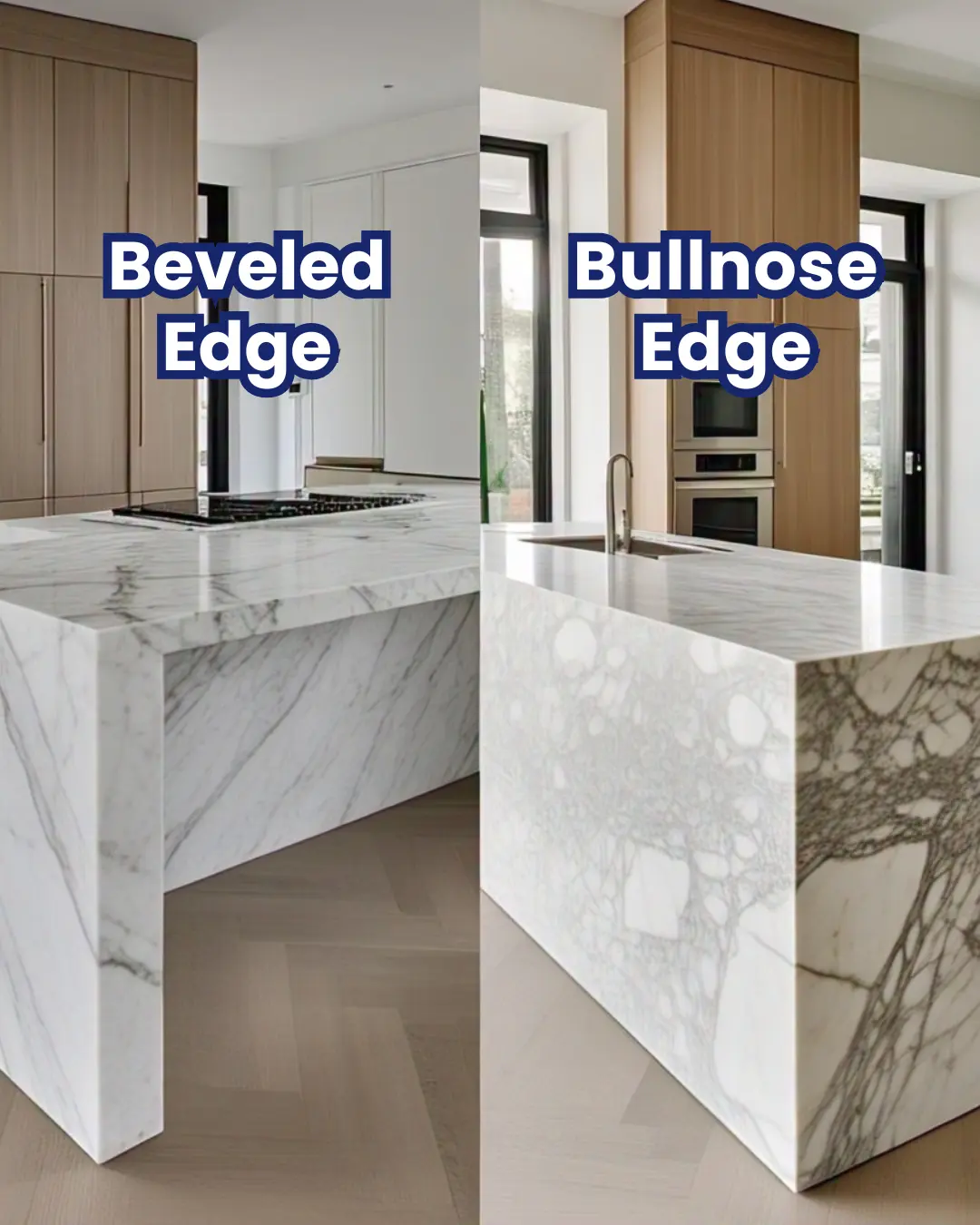
- Beveled: Flat, slanted edge.
- Bullnose: Fully rounded edge.
- Which is better? Bullnose is softer; beveled is sharper in style.
Related: Bullnose Edge Countertops: The Smooth and Safe Choice
Beveled vs Ogee
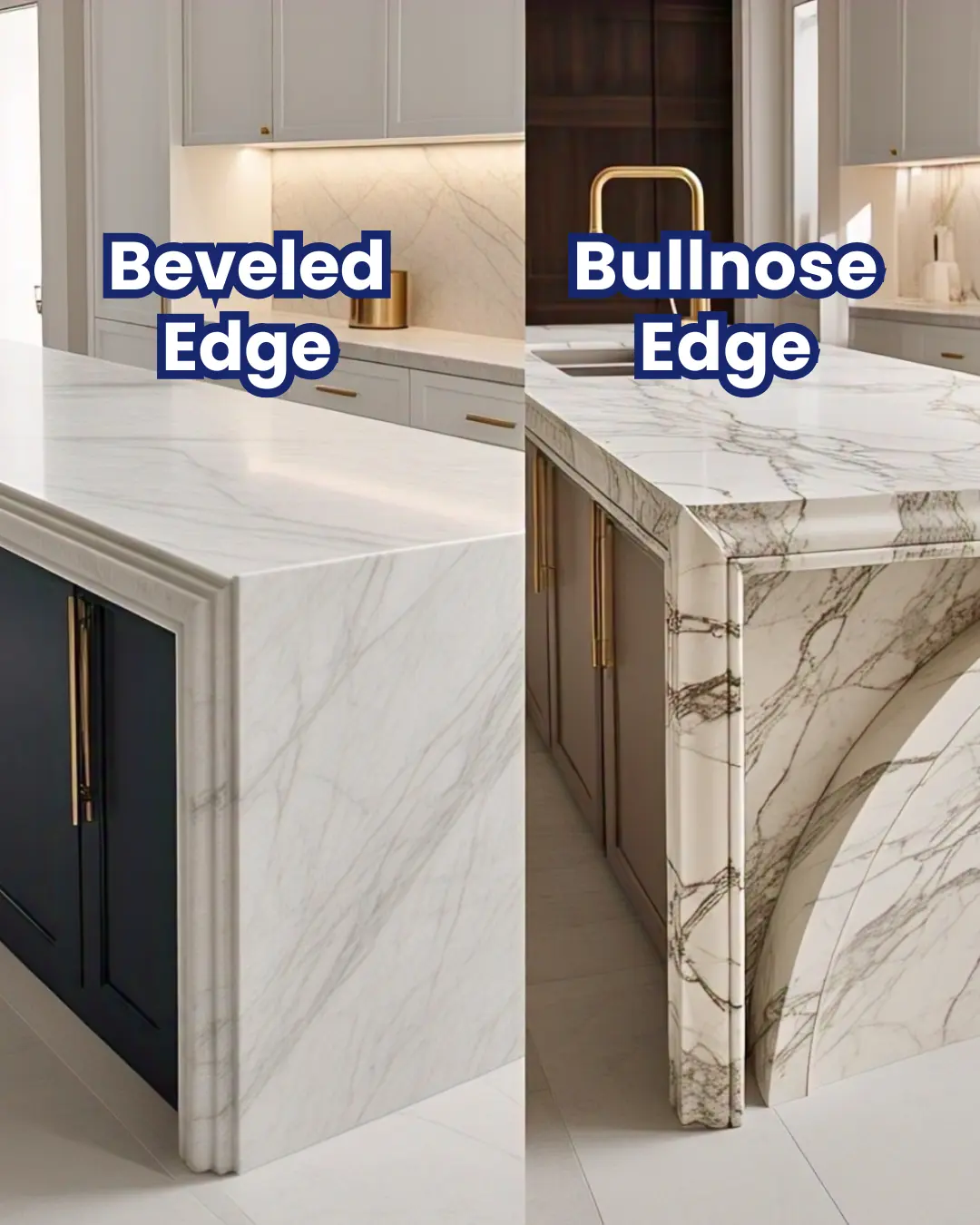
- Beveled: Simple slant.
- Ogee: Fancy S-shaped curve.
- Which is better? Ogee is more traditional. Beveled is sleek and clean.
Best Materials for Beveled Edge Countertops
Beveled edges add a stylish touch, but not all materials handle the angled cut equally well. Here are the top choices and what makes them special:
1. Quartz (Engineered Stone) – Best Overall
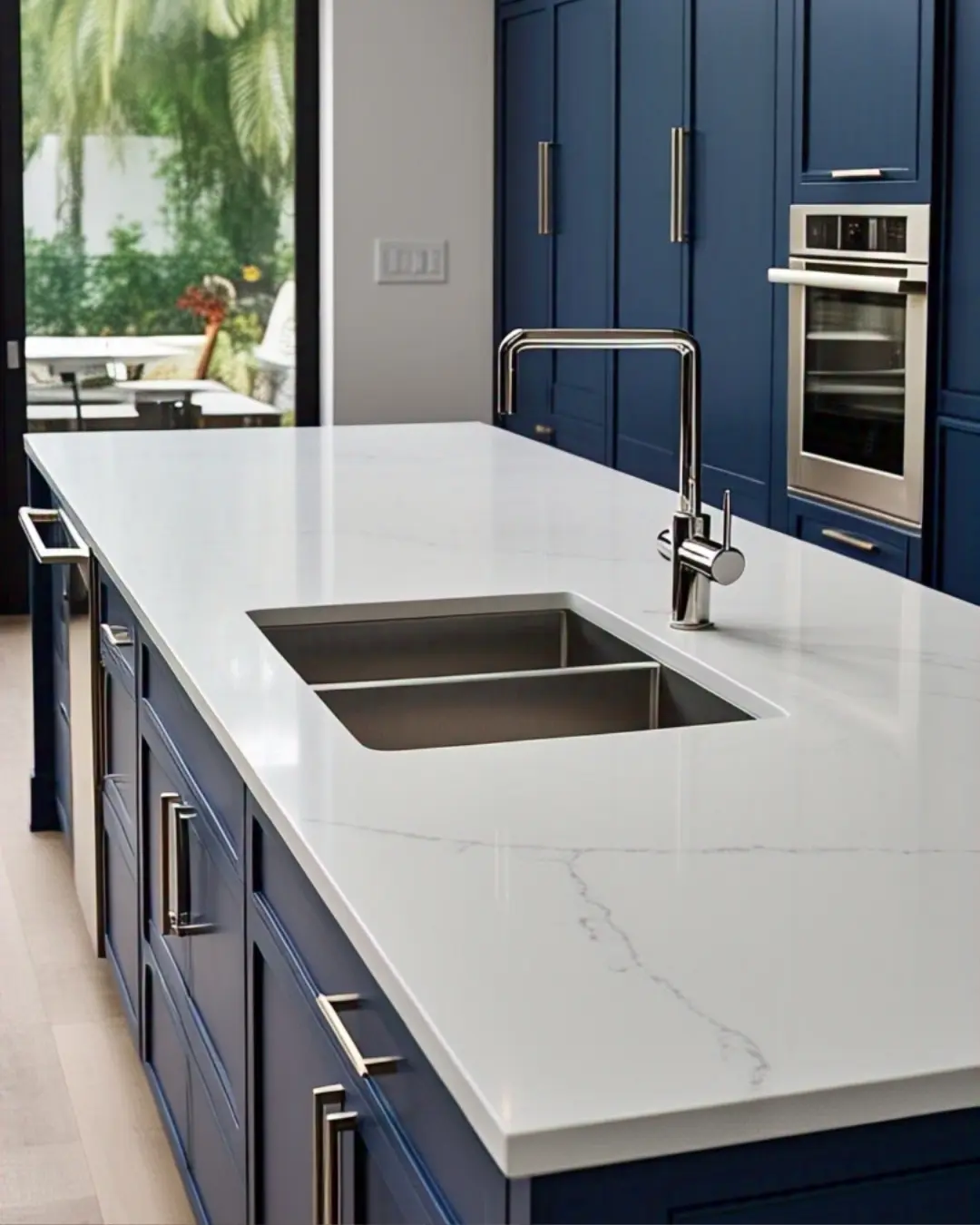
✔ Why? Non-porous, scratch-resistant, and consistent color (no surprises!).
✔ Bevel Perk: Sharp, clean angles won’t chip easily.
✔ Best For: Kitchens & bathrooms (low maintenance).
⚠ Watch Out: Avoid heavy impact (like dropping pans).
Also Read: Half-Bullnose Edge Countertops
2. Granite (Natural Stone) – Classic & Durable
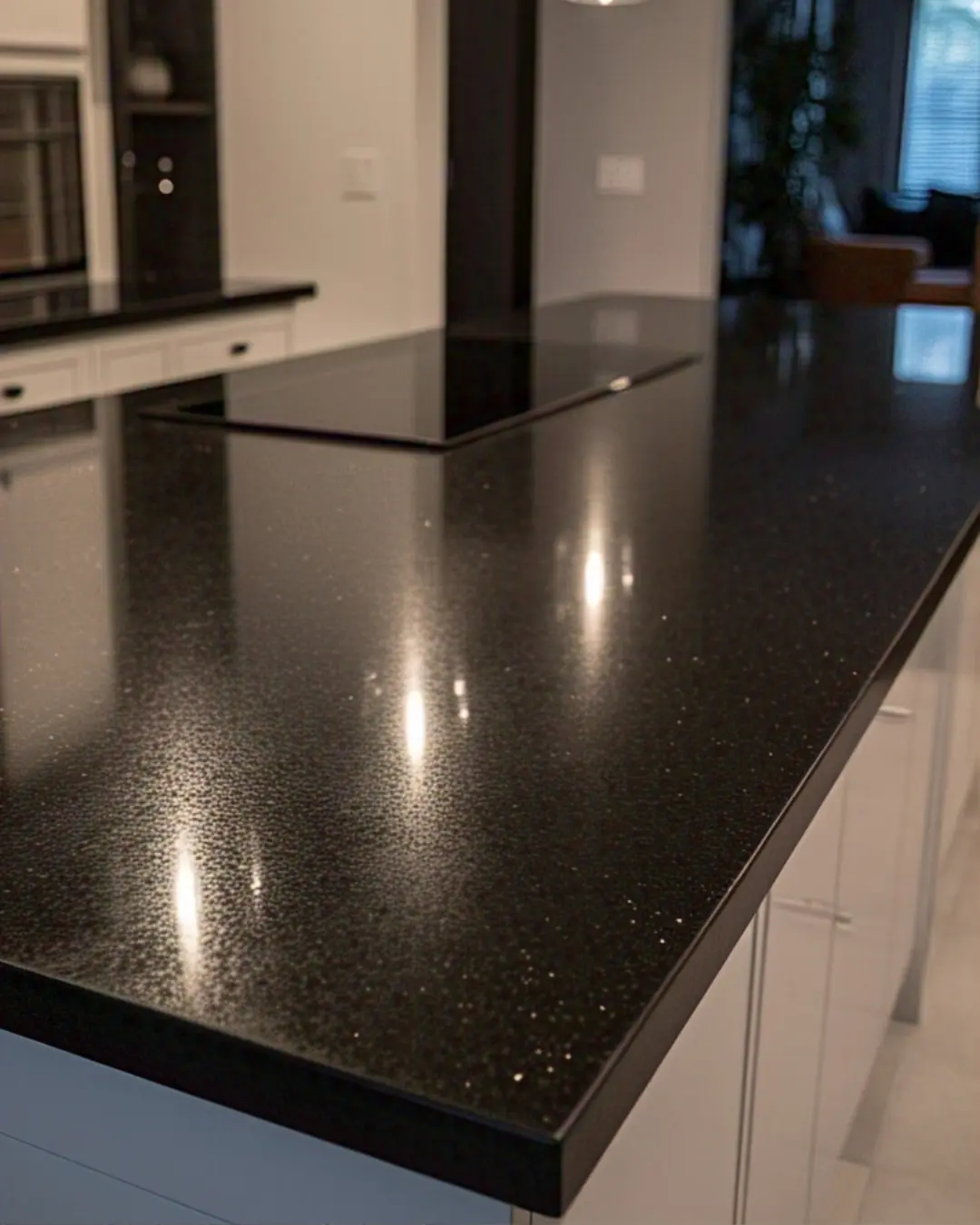
✔ Why? Heat-resistant and unique veining patterns.
✔ Bevel Perk: Hides seams better than straight edges.
✔ Best For: Busy kitchens (stands up to heavy use).
⚠ Watch Out: Needs yearly sealing.
3. Laminate – Budget-Friendly
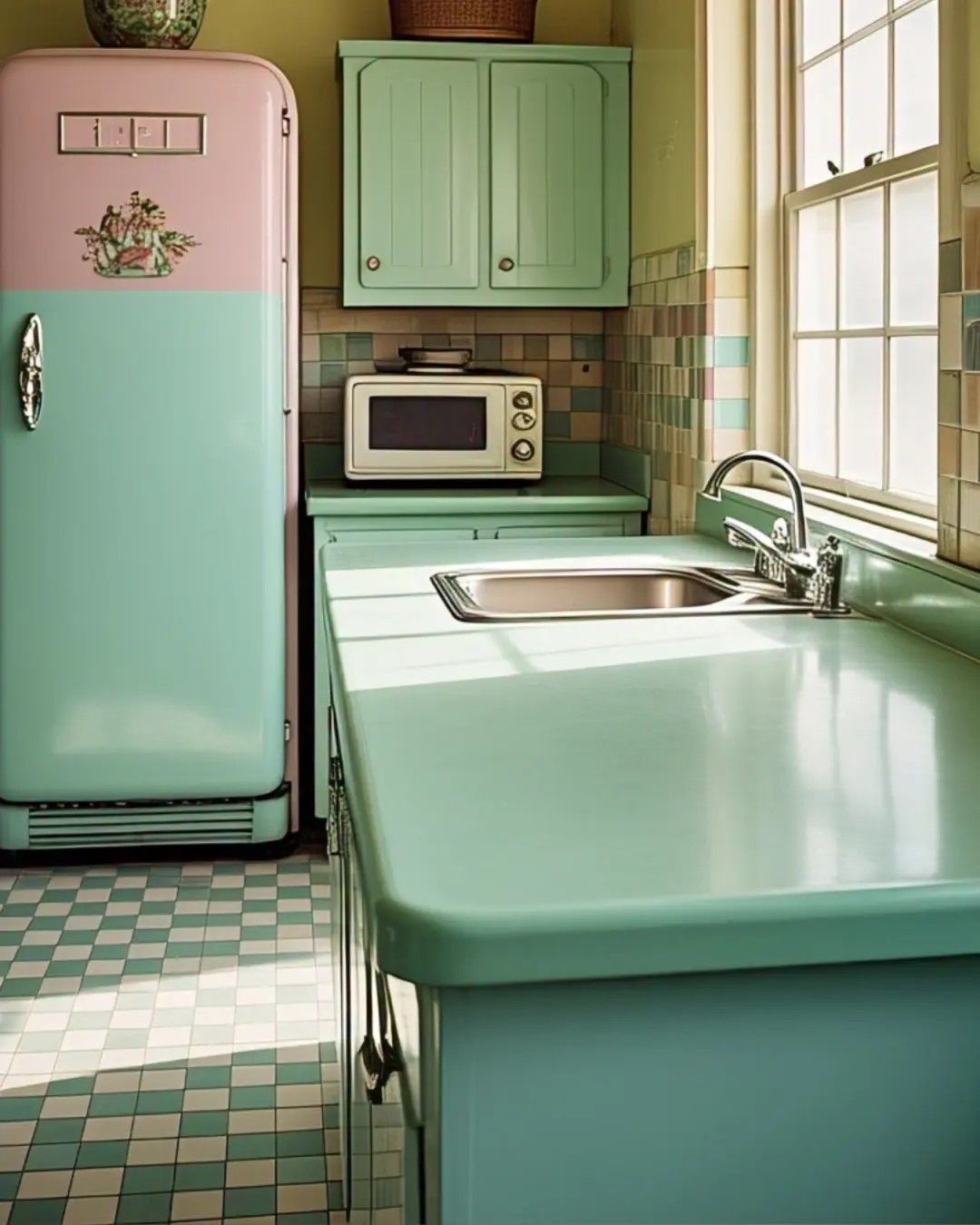
✔ Why? Cheap, lightweight, and comes in endless colors.
✔ Bevel Perk: Pre-fab options often include beveled edges.
✔ Best For: Rentals or DIY projects.
⚠ Watch Out: Scratches easily (no hot pans!).
4. Solid Surface (Corian) – Seamless Look
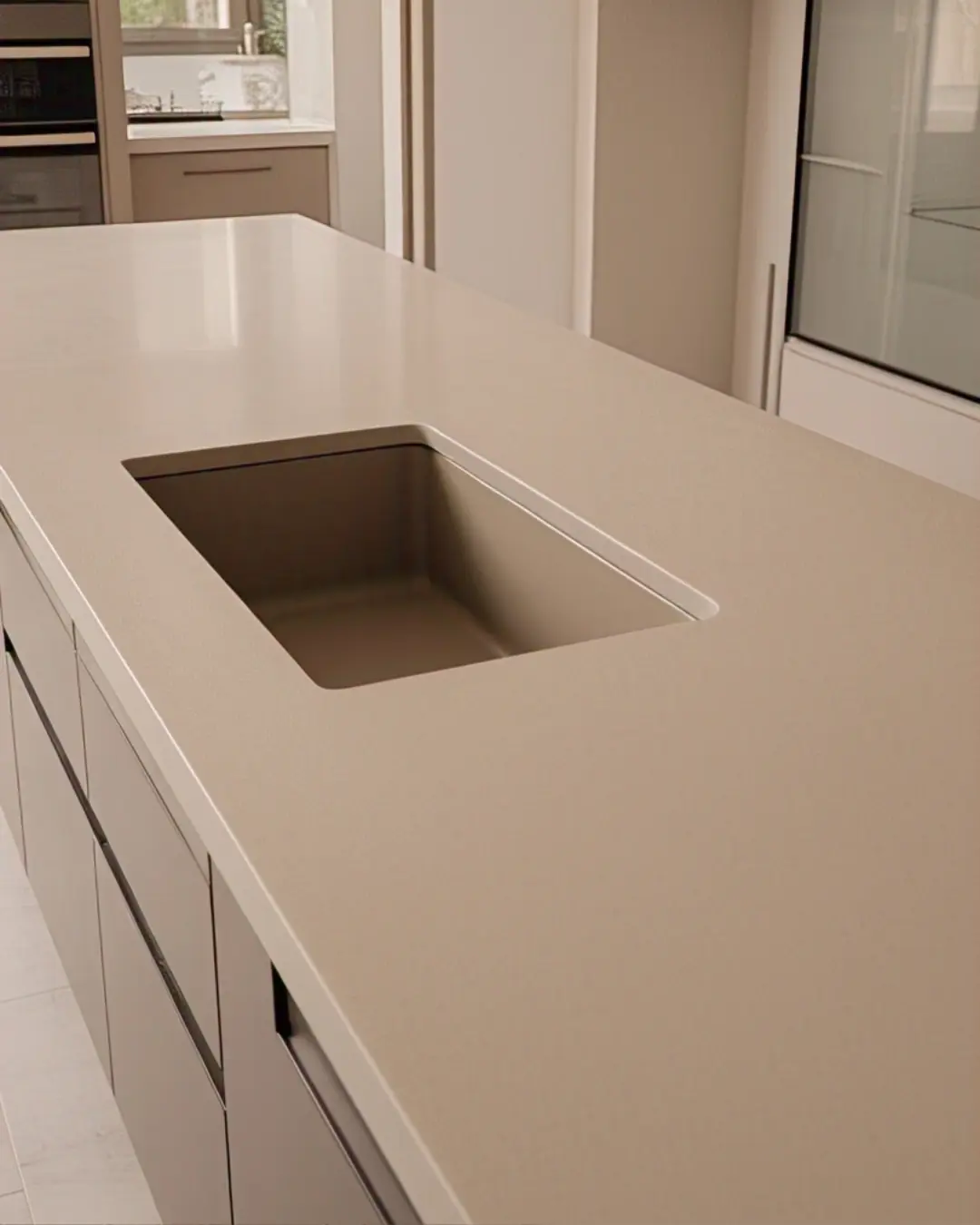
✔ Why? Can be sanded if scratched (great for families).
✔ Bevel Perk: Easy to polish rounded bevels.
✔ Best For: Bathrooms or curved counters.
⚠ Watch Out: Not heat-resistant.
5. Butcher Block (Wood) – Warm & Inviting
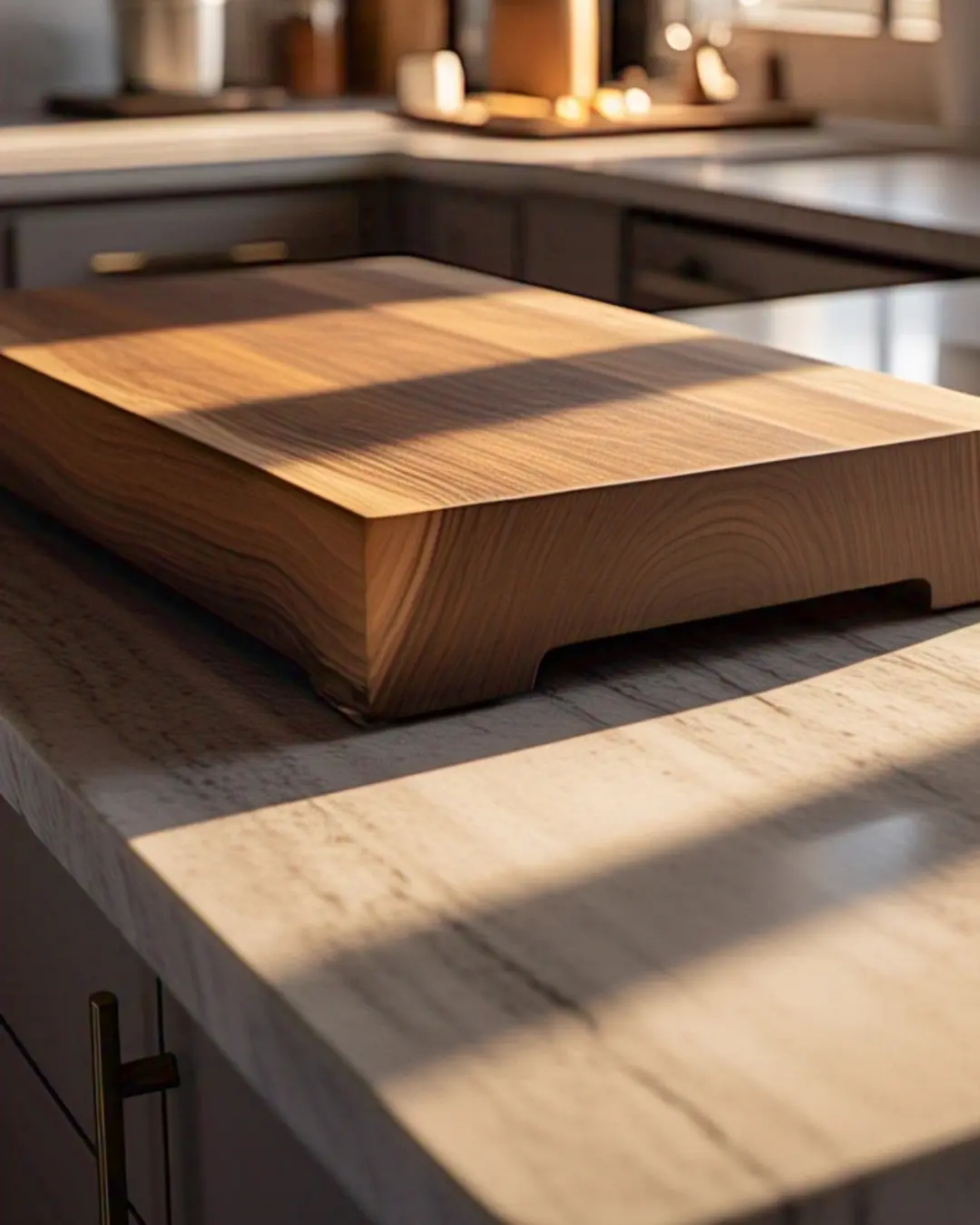
✔ Why? Soft bevels complement rustic styles.
✔ Bevel Perk: Easier to sand than sharp edges.
✔ Best For: Farmhouse kitchens or islands.
⚠ Watch Out: Needs oiling every few months.
Materials to Avoid with Beveled Edges
- Concrete: Bevels may crack over time.
- Thin Porcelain: Too brittle for angled cuts.
- Recycled Glass: Edges can look uneven.
Best Rooms for Beveled Edge Countertops
Beveled edges add a touch of elegance without being overly fancy, making them a versatile choice for multiple spaces. Here’s where they work best:
1. Kitchens (The Classic Spot)
✔ Why? The angled edge resists chipping and hides crumbs better than sharp edges.
✔ Best Bevel Type: Standard or double bevel for a clean, modern look.
✔ Material Match: Quartz (durable) or laminate (budget-friendly).
2. Bathrooms (Elevated Style)
✔ Why? Adds subtle sophistication to vanities without overwhelming small spaces.
✔ Best Bevel Type: Soft bevel (safer for elbows and cosmetics).
✔ Material Match: Porcelain or marble for a spa-like feel.
3. Wet Bars & Entertainment Areas
✔ Why? The bevel catches drips, protecting cabinets from water damage.
✔ Best Bevel Type: Decorative bevel for a luxe touch.
✔ Material Match: Granite (stain-resistant) or quartzite.
4. Laundry Rooms (Practical + Pretty)
✔ Why? The slope helps direct water toward the sink.
✔ Best Bevel Type: Standard bevel (low-maintenance).
✔ Material Match: Laminate (cost-effective for utility spaces).
5. Home Offices (Desk Upgrade)
✔ Why? Makes work surfaces look custom-designed.
✔ Best Bevel Type: Double bevel for a sleek, professional vibe.
✔ Material Match: Butcher block (warmth) or matte quartz.
Rooms to Avoid
❌ Outdoor Kitchens (Bevels can trap dirt in harsh weather).
❌ Kids’ Craft Rooms (Glue/paint may stick in angled edges).
Pro Tip: In small rooms (like half-baths), a beveled edge makes counters appear thicker and more expensive!
Benefits of Beveled Edge Countertops
Here’s why people love beveled edges:
- Modern Style: Looks sleek and fresh.
- Easy Cleaning: No curved spots for crumbs to hide.
- Less Chipping: Stronger edge than some fancier styles.
- Shiny Finish: Polished bevels reflect light and add shine.
- Works with Many Materials: Granite, quartz, marble—you name it!
Any Downsides?
Nothing is perfect, right? Here are a few cons:
- Sharp Corners: Might not be great with small kids.
- Dust in Corners: Dirt can build up in the slanted groove.
- Costs More: Might cost a little more than straight edges.
How to Clean a Beveled Edge Countertop
Cleaning a beveled edge is easy if you know how.
What You’ll Need:
Steps:
- Wipe the top and edge with a wet cloth.
- Use a little soap if it’s dirty.
- Scrub the slanted part gently with a toothbrush.
- Dry it with a soft towel to avoid water spots.
Tips to Keep It Looking New
- Don’t place hot pots directly on it.
- Use cutting boards to avoid scratches.
- Wipe spills right away.
- Clean weekly with a soft cloth.
- Don’t use strong cleaners—they can damage the finish.
Cost of Beveled Edge Countertops
The price of a beveled edge countertop depends on three things:
- Material (laminate vs. quartz vs. granite)
- Type of Bevel (simple or decorative)
- Installation (DIY vs. professional)
💰 Price Breakdown (Per Square Foot)
| Material | Basic Bevel Cost | Fancy Bevel Cost |
|---|---|---|
| Laminate | 20−20−50 | 30−30−60 |
| Quartz | 50−50−100 | 70−70−120 |
| Granite | 40−40−90 | 60−60−110 |
| Marble | 60−60−120 | 80−80−150 |
*Note: Fancy bevels (like decorative or double) cost 15-30% more than basic ones.*
💸 Extra Costs to Remember
- Installation: 300−300−800 (unless you DIY)
- Sink Cutouts: 100−100−300 extra
- Sealing (for stone): 200−200−500 every few years
💡 3 Ways to Save Money
- Pick laminate – Cheaper but still looks great with a bevel!
- Choose standard bevel – Fancy edges add $$$
- Reuse existing cabinets – No need to replace them!
🤔 Is It Worth It?
✅ Yes, if: You want a small upgrade that makes your kitchen look more expensive.
❌ No if: You’re on a tight budget (straight edges are cheaper).
Pro Tip: Ask for a “dry-fit” before final install to avoid expensive mistakes!
Can you create a beveled edge yourself, or should you hire a professional?
Creating a beveled edge yourself is possible with wood or laminate countertops if you have woodworking tools and experience.
However, for stone like marble or quartz, you’ll need specialized tools like an angle grinder with a diamond blade. Mistakes can lead to chipping or uneven edges, risking costly damage.
DIY is best left to those with stone fabrication skills.
For a flawless finish, hiring a professional is the safer choice. Stone fabricators use CNC machines or precision hand tools to create clean, polished bevels.
They also properly seal the edge to prevent damage. Investing in professional work ensures durability and a high-end result, especially with expensive materials.
Final Thoughts
A beveled edge countertop is a small detail that makes a big difference. It’s stylish, strong, and fits almost any home. Whether you’re redoing your kitchen or just want a fancy bathroom, beveled edges are a smart and beautiful choice.
FAQs about beveled edge countertop
Is a beveled edge safe for kids?
It’s a bit sharper than rounded edges, so be careful with toddlers.
Can I put beveled edges on laminate countertops?
Yes! Many laminate options offer beveled edge styles.
Will a beveled edge chip easily?
It’s actually tougher than some fancy edges, but no edge is 100% chip-proof.
Is a beveled edge countertop expensive?
It can cost a bit more than a straight edge, but it looks more stylish.
Can I add a beveled edge later?
It’s best done during installation. Adding it later is hard and risky.
Also, don’t forget to update your home with house making ideas. Let us make your home look beautiful.
